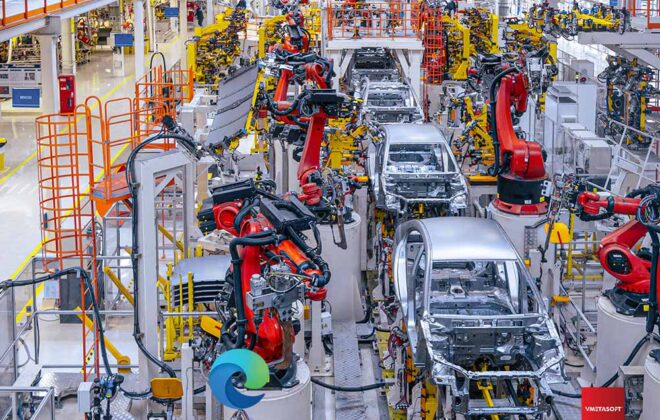How Vmetasoft® Train and Deploy Generative AI for Business Automation?
Generative Artificial Intelligence (AI) has revolutionized the field of machine learning by enabling computers to create new content, such as images, music, and text, that closely resembles human-generated data. Training and deploying generative AI models require careful planning and execution. In this blog post, we will explore the steps involved in training and deploying generative AI models, providing you with a comprehensive guide to harnessing the potential of this cutting-edge technology.
Define the Objective
The first step in training and deploying generative AI is to clearly define the objective of your project. Determine what type of content you want the model to generate, such as images, music, or text, and specify any specific characteristics or constraints you want the output to possess.
Collect and Pre-process Data
Next, gather a diverse and representative dataset that aligns with your objective. This dataset will serve as the training material for your generative AI model. Ensure that the data is labeled correctly and is of high quality. Pre-process the data by cleaning, normalizing, and transforming it to make it suitable for training.
Choose an Architecture
Select an appropriate architecture for your generative AI model. Depending on the nature of your task, you can choose from a range of architectures such as Variational Autoencoders (VAEs), Generative Adversarial Networks (GANs), or Transformers. Each architecture has its strengths and weaknesses, so choose the one that best aligns with your project’s objectives.
Train the Model
Training a generative AI model involves exposing it to the labelled data and iteratively adjusting its parameters to minimize the difference between the generated output and the real data. The training process typically involves defining loss functions, optimizing hyperparameters, and running multiple iterations until the model converges. This process may require significant computational resources and time.
Evaluate and Fine-tune
Once the model is trained, evaluate its performance using appropriate metrics. Assess the quality and diversity of the generated output and compare it to the real data. Fine-tune the model by adjusting hyperparameters or incorporating additional training techniques, such as regularization or data augmentation, to improve its performance.
Deployment Considerations
Before deploying a generative AI model, consider the following factors:
- Resource Requirements:
Determine the computational resources, memory, and processing power needed to deploy and run the model effectively.
- Latency and Throughput:
Assess the time it takes for the model to generate output and ensure it meets the desired latency and throughput requirements.
- Scalability:
Plan for scalability by considering how the model will handle increased demand and workload. Consider techniques such as model parallelism or distributed computing.
- Ethical Considerations:
Evaluate the ethical implications of deploying a generative AI model, especially if it involves generating content that could be misleading, harmful, or infringe upon privacy rights.
Model Deployment
Deploying a generative AI model involves integrating it into a production environment where it can generate content in real-time or on-demand. Consider the infrastructure, frameworks, and libraries needed to support the model’s deployment. Monitor the performance of the deployed model and continuously update it as new data becomes available or improvements are made.
Conclusion
Training and deploying generative AI models hold immense potential for creating novel and realistic content across various domains. By following a systematic approach to define objectives, collect and pre-process data, choose appropriate architectures, train and fine-tune the model, and consider deployment considerations, organizations can unlock the power of generative AI. It is important to approach the deployment of generative AI models with care, ensuring ethical considerations and responsible usage are given due diligence. With continued advancements in this field, the possibilities for generative AI are boundless, and it is up to us to leverage this technology responsibly and ethically to shape a better future.
Related Posts
- Agriculture
- Artificial Intelligence
- Big Data
- Business Process Improvement
- Business Process Re-engineering
- Cloud Computing
- CRM software
- Cyber Security
- Data Mining
- Data science
- Data Storage Technology
- DataBase
- DevOps Environment
- Digital Transformation
- ERP Software
- Fraud Prevention
- How to Solve
- IoT: Internet of Things
- Java
- Logo Design
- Product Development
- Uncategorized
- Ux Design
- Virtual Reality Technology
- Web Development
- Work Culture
ANN artificial intelligence Artificial Neural Network asset management attack branding buisness buisness development buisness software buisness technology cloud computing CRM Software database data mining digital transformation ERP Software generative ai growth rate how to hr human capital management software hybrid iass India inventory management java progamming language logo design machine learning microsoft edge modernization mtbf mttr pass performance prevention private public ransomware red hat enterprise linux sass smart manufacturing soc SSD training and deployment unistall
Recent Comments
Thank You
Thank you Zen
Thank you Cerebrozen
Really a insightful bog
We really apprecite Vmetasoft affort, helping our brand with SOC. We are really proud to be partnered with Vmetasoft Inc.





